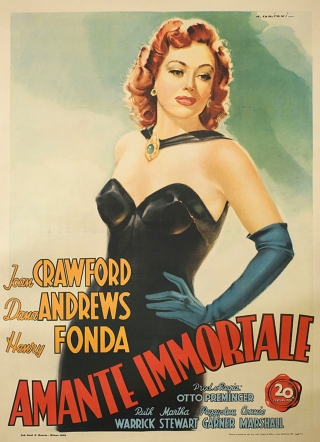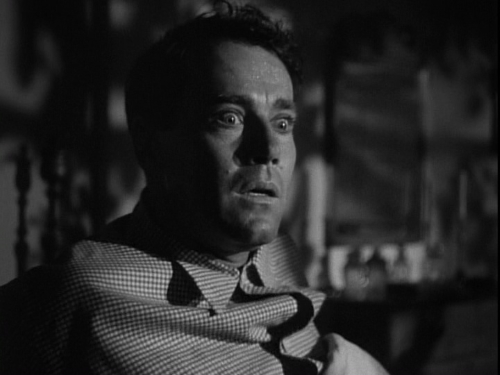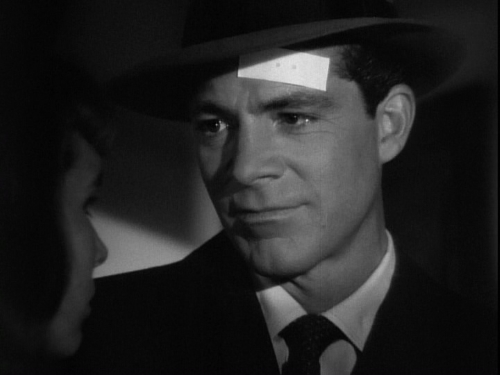The magic of marketing – hang a label on a movie, point to the genre pedigree of the headline stars, and the director for that matter, and and there we have a film noir. Or actually we don’t, we have a film sold as such, at least it was back when Fox Film Noir was an ongoing line in the heyday of DVD releasing. Daisy Kenyon (1947) is a very well made and enjoyable post-war romantic melodrama but regardless of what it says on the tin, it’s certainly not a film noir. OK, having got that out of the way, I do want to take a look at a movie which sees three top stars all doing excellent work with one of Hollywood’s finest directors and getting plenty of mileage out of that frank openness about human relationships and bloomed in the years following WWII.
There is something attractive about frankness, especially with regard to those relationships that might be seen as falling below contemporary standards of propriety. Otto Preminger was always good at bringing such material to the screen and there’s a refreshing lack of judgement on display as we follow the complicated and meandering love lives of the three principals. At the center of it all is Daisy Kenyon (Joan Crawford), an unwed artist who has been carrying on an affair with a married hotshot lawyer, Dan O’Mara (Dana Andrews). Right from the first scene it’s apparent that this is unsatisfactory, from Daisy’s perspective anyway. She’s not stricken by guilt or remorse or any of the other trite reactions typically forced upon characters in this position. No, she’s just tired of taking second place whenever some important business or social engagement arises, and of course time is not in the habit of waiting around for anyone. With this in mind, she has one of her periodic spats with O’Mara and sets about preparing for a date with a new romantic prospect. Peter Lapham (Henry Fonda) is a soldier and one time boat designer. In one of those delightfully quirky scenes that punctuate the movie, both her suitors run into each other in the doorway and wind up using the same cab to shuttle back and forth, just not together. The romantic rivalry between the two men hasn’t grown any teeth at this stage, that will come later but there is a quality to it from the off that I can only describe as screwball drama. If O’Mara is not the ideal pick for Daisy given his marital commitments, Lapham has other issues. it’s not explicitly stated but he’s clearly affected by PTSD, as well as a degree of guilt/remorse for the death of his wife. I don’t want to go into too many details here, suffice to say the story devolves into a kind of contest for Daisy’s heart with the well-being and contentment of O’Mara’s children as a form of collateral up for negotiation. Maybe the outcome isn’t entirely surprising but the road that takes us there is pitted with plenty of drama, a sprinkling of black humor and a liberal dose of good old-fashioned empathy.
Preminger blends this all expertly, getting first class performances from his three leads. Henry Fonda was rebuilding his Hollywood career after wartime service in the navy. He would make My Darling Clementine and The Fugitive for Ford and then Fort Apache, with this movie and The Long Night giving him the chance to work with other directors in between. He brings something slightly offbeat to his role, an attractive quality which while not quite offering the lush oddness to be found in William Dieterle’s wonderful Portrait of Jennie and Love Letters is satisfyingly quirky and somehow authentic. Andrews is more grounded, less ethereal in his part. He’s driven by a desire that feels vaguely juvenile in its approach – as Crawford tells him late on, he’s as much spurred on by a need to escape responsibility as any need to achieve stability. Still, that unrest that Andrews was so adept at harnessing is always bubbling just below the surface. Crawford was riding high after her success in Mildred Pierce and gives a performance that is confident and credible. The fact is all three play off each other in a way that engages rather than overwhelms the viewer. Add in Leon Shamroy’s evocative camerawork and a characteristically classy score from David Raksin and the result is a polished and meaningful piece of filmmaking.
As I said at the start, Daisy Kenyon is not a film noir and I’m not sure how it came to be marketed as such. Perhaps it’s the combination of the reputations of the stars and director alongside some shadowy cinematography. The old Fox DVD sported a middling transfer, with some very blurry sections. I can’t say for sure whether or not this was intentional yet I doubt it somehow. Even though I understand the later Kino Blu-ray exhibits the same, I suspect print damage of some kind is more likely at the back of it. However, none of that should spoil one’s enjoyment of the movie. The DVD (and I think the Blu-ray too) has some worthwhile supplements with short features on the making of the movie and on Preminger’s career. Among the contributors is the always welcome and interesting Foster Hirsch – revisiting this movie and listening to his comments has reminded me that I need to pick up a copy of his book on Preminger. I think anyone who hasn’t seen this film will find it a rewarding watch. Just don’t go in expecting to see a film noir.




Excellent review. As a fan of all involved I will have to see this. Preminger’s career fascinates me and I really enjoy Hirsch’s bio of him. Actually one of my favorites on a director and his account of when Preminger fell apart as a director in the late ’60s and ’70s is particularly interesting.
LikeLike
I will get the Hirsch book, it’s been on my radar for a while now. I recently bought another book on Preminger by Chris Fujiwara and I plan to dip into that soon.
LikeLike
Yes, I like that bio too.
LikeLiked by 1 person
Great review 🙂 Daisy Kenyon is actually my third favorite film by legendary director Otto Preminger. Speaking of Preminger noirs (and yes, I am aware Daisy Kenyon is not really one of them), did you ever see 1952’s Angel Face? For my money, that is my number one favorite of Otto Preminger’s noir films and I love all of them 🙂
LikeLike
‘Angel Face’ is amazing. That ending!
LikeLiked by 2 people
You got that right Chris 🙂
LikeLike
John, the obvious question here is: what are the other two Preminger titles you rate highly?
I am a big fan of Angel Face – I wrote a post on it here many years ago. I bought the Warner Archive Blu-ray a while back and watched the movie again – it looks marvelous.
LikeLiked by 1 person
I particularly enjoy Eddie Mueller’s commentary on the disc. I like when he name checks one of my favorite Preminger films ‘Anatomy of a Murder’ during the crazy trial scenes.
LikeLike
Colin I will name under the condition that you pretend to be surprised when I do a blog entry regarding all of my favorite Otto Preminger films 🙂
LikeLike
Do you have ‘Advise & Consent’ and ‘In Harm’s Way’ toward the higher range? One of your two has to be ‘Laura’ the legend that it is.
LikeLiked by 1 person
They are within the top 10 Chris 🙂 Just don’t expect to see A Royal Scandal, Forever Amber and Rosebud on there when it is finally posted on my site because the three I just mentioned are easily Preminger at his worst, but other that, I love everything else including Advise & Consent, In Harm’s Way and Laura 🙂
LikeLiked by 1 person
Thanks for the reply. So you disagree with the critics on ‘Skidoo’ and ‘Hurry Sundown’? Late Preminger gets so lambasted.
LikeLiked by 1 person
Yes. Skidoo could even be seen as a metaphor for how Preminger was adjusting to the changing morales of the 1960’s and his use of stars who had been big during previous decades could even be autobiographical of himself at least from a creative standpoint. Though it has been reported that Preminger took LSD while making it or before making it. I read that his way of trying to connect with his son Erik from his affair with Gypsy Rose Lee.
LikeLike
My Preminger Top Five would definitely include Bunny Lake Is Missing. Great movie.
LikeLike
I hadn’t realized you had plans for a blog post on your favorites among the director’s work. In that case, I won’t press and instead I’ll let you reveal all in your own time when you’re good and ready.
LikeLiked by 1 person
Sometimes a melodrama is just a melodrama 🙂 I have the Fox DVD and agree completely with your assessment. In terms of the high value cast, I think Fonda sticks out a bit in this one, not quite sure he is really in the same movie as everyone else tbh 🙂
LikeLiked by 1 person
Fonda’s work here is different, isn’t it? It works for me though in the context of a character who has been deeply affected by the war/past experiences and is thus approaching life from a very different angle. There were a number of post-WWII movies that explored that to a greater or lesser extent and I find them quite compelling.
LikeLiked by 1 person
And of courses lot of those movies really do count as Film Noir but yes, the returning war veteran, whether a Martin Guerre style exploration of identity or stories or of mental or physical rehabilitation made for a rich sub category.
LikeLike
Yes, I like that sub-genre a lot, even if some of those movies only partially succeed. There’s something regretful, winsome and hopeful all rolled together about them, very much a product of their time and circumstances but with a kind of timeless quality too.
LikeLiked by 1 person
time I watched Daisy KENYON again. I imagine Joan was pleased to have Fonda and Andrews costarring. I liked the contrast between the two male characters.
LikeLiked by 1 person
Yes, that contrast is a big part of what makes the movie interesting, two actors who approached their work in different ways and brought very different characterizations out at least partly as a result.
LikeLike
A fine movie. It obviously would have been better without Henry Fonda, but you can say that about all of Henry Fonda’s movies.
LikeLike
I thought Advise and Consent was Otto’s best film, with a single false step relative to Don Murray’s character.
LikeLike
I think Preminger stared to go off the rails when he started trying to make Big Important Movies. Movies that Confront the Vital Issues of Our Day. Such movies always bore me.
My favourite Preminger movies are his more intimate movies focused on human dramas – Laura, Fallen Angel, Angel Face, Bunny Lake Is Missing, Bonjour Tristesse.
I guess I’m more interested in people than issues.
LikeLike
I know ‘Anatomy of a Murder’ is an examination of the justice system but it gets at human beings too. The characters feel very real to me. How people are. I think he gets at our essential being in that film. So I very much admire it.
LikeLiked by 1 person
Yes, I’d go along with that too. Looking at a system, a society, beliefs of philosophies are just frameworks for examining or highlighting how people live within (or without) them and how they respond to them. The scale of the story doesn’t or its ambition is not necessarily related to how intimately the characters populating it are drawn.
LikeLike
I’ll tell ya one thing Colin … that’s a poster that would make me go to a movie.
LikeLiked by 2 people
Does the job, doesn’t it? I really like Italian posters of the era and like to feature examples when possible.
LikeLiked by 2 people